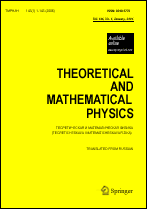|
|
Teoreticheskaya i Matematicheskaya Fizika, 1976, Volume 28, Number 3, Pages 308–319
(Mi tmf4263)
|
 |
|
 |
This article is cited in 12 scientific papers (total in 12 papers)
Combined algebra for quantum and classical mechanics
Yu. M. Shirokov
Abstract:
For a canonical Hamiltonian system, an algebra is constructed in which all the
observables are realized by ordinary functions $A(p,q)$ of the momenta and coordinates and are simultaneously classical and quantum observables. The classical and quantum states are realized by density matrices $\rho(p,q)$ that are either coincident for the quantum and the classical theory or exist only in one of the theories. The entire difference between the quantum and classical descriptions reduces to the difference between the quantum and classical operations of multiplication of observables, their Poisson brackets, and thus between the evolutions of the observables (or states) in time. A transition from the quantum to the classical theory is proposed and investigated in which the observables and states do not change and the operations of quantum multiplication and taking of the quantum Poisson brackets go over as $\hbar\to0$ into the
corresponding classical operations in a perfectly definite sense. It is shown that the quantum operations are infinitely differentiable with respect to $\hbar$ at zero. The transition to classical mechanics is possible for all observables but not for all states. Pure quantum states become mixed in the classical case. The quantum corrections destroy the Hamiltonicity of the classical equations of motion. For the space of observables a topology which admits unbounded operators is used.
Received: 04.01.1976
Citation:
Yu. M. Shirokov, “Combined algebra for quantum and classical mechanics”, TMF, 28:3 (1976), 308–319; Theoret. and Math. Phys., 28:3 (1976), 806–813
Linking options:
https://www.mathnet.ru/eng/tmf4263 https://www.mathnet.ru/eng/tmf/v28/i3/p308
|


| Statistics & downloads: |
| Abstract page: | 509 | | Full-text PDF : | 218 | | References: | 50 | | First page: | 1 |
|




 Contact us:
Contact us: Terms of Use
Terms of Use
 Registration to the website
Registration to the website Logotypes
Logotypes








 Citation in format
Citation in format 
